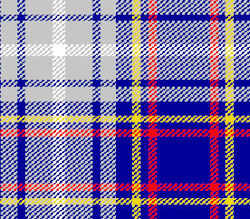Nevada State Tartan
Nevada Tartan

Adopted on March 14, 2001
Governor Kenny Guinn signed Senate Bill No. 347 on May 8, 2001, designating a tartan, designed by Richard Zygmunt Pawlowski, as the official state tartan of the State of Nevada.
Tartan refers to fabric woven into plaid patterns representing clans (families) or regions in Scotland.
In old Scotland, the tartan was used for clothing and as a banner or flag. Because a family or community worked the cloth together, their clothing was made of the same patterns, and so a person could be recognized by the Tartan plaid that he wore. Tartans can also be designed as a symbol commemorating a special event or person.
Nevada State Tartan: Nevada tartan
The colors and design of the tartan represent the many features that make Nevada a unique and bountiful state.
- Blue represents one of the state colors of Nevada, the pristine waters of Lake Tahoe and the mountain bluebird.
- Silver represents the other state color,and the official state mineral.
- Red represents the Virgin Valley black fire opal, and the red rock formations of southern Nevada.
- Yellow represents sagebrush and symbolizes the great basin region of central Nevada.
- White represents the name of this state meaning snow-covered, which is the translation of the Spanish word "nevada".
- The crossing of the yellow and red stripes represents the different colors of Nevada sandstone.
- The white intersection on the silver field stands for the snow-capped peaks of granite mountains, which make up the Sierra Nevada mountain range.
- The four blue lines represent the four main rivers of Nevada which are the Colorado River, Truckee River, Humboldt River and Walker River.
- The intersecting blue lines in the silver field represent the Colorado River as it meets Hoover Dam and creates Lake Mead.
- The small solid "boxes" of silver and blue number 8 by 8, or 64, to signify the year (1864) that Nevada was admitted into statehood.
- The 13 solid-colored intersections of the small stripes represent Boundary Peak, the highest point in Nevada, which stands at an elevation of 13,143 feet.
- Finally, the 16 solid silver intersections and the solid white intersection in the center of the tartan represent the 16 counties and the one consolidated city-county government of Nevada.
Tartan Details - Nevada State
The information held within The Scottish Register of Tartans for the "Nevada State" tartan is shown below.STA ref: 3091
STWR ref: 2947/
Designer: Pawlowski, Richard Zygmunt
Tartan date: 14/03/2001
Registration date: Not Specified
Category: District
Restrictions:
Registration notes: Adopted as the Nevada State tartan on the 14th March 2001. Designed by California born Rick Zygmunt Pawlowski ('Ziggy') and officially adopted by the state in March 2001. The blue and silver represent Nevada's state colours. Red is for the Virgin Valley black fire opal and the red rock formations of southern Nevada; yellow is for the sagebrush, the state flower; white is for the name of the state - Nevada is Spanish and means snowy or snow clad, a reference to the US Sierra Nevada mountain range that runs down the eastern border of California, overlooking Nevada. Other symbolic references are detailed in the US Senate Bill No. 347. Design input also from Alistair Buchan and Leah Robertson, Lochcarron of Scotland.
Nevada Law
The law designating the official Nevada state tartan is found in the Nevada Revised Statutes, Title 19, Chapter 235, Section 235.130.
CTITLE 19- MISCELLANEOUS MATTERS RELATED TO GOVERNMENT AND PUBLIC AFFAIRS
CHAPTER 235 - STATE EMBLEMS; GIFTS AND ENDOWMENTS
MISCELLANEOUS STATE EMBLEMS
NRS 235.130 State tartan.
1. The tartan designed by Richard Zygmunt Pawlowski and further described in this section is hereby designated as the official
state tartan of the State of Nevada. The colors and design of the tartan represent the following features that make Nevada a unique and bountiful state:
(a) Blue represents one of the state colors of Nevada, the pristine waters of Lake Tahoe and the Mountain Bluebird, the official
state bird;
(b) Silver represents the other state color, the official state mineral, the granite composition of the Sierra Nevada Mountain
Range and the silver country of northern Nevada;
(c) Red represents the Virgin Valley black fire opal, the official state precious gemstone, and the red rock formations of southern
Nevada;
(d) Yellow represents Sagebrush, the official state flower, and symbolizes the Great Basin Region of central Nevada;
(e) White represents the name of this state meaning snow-covered, which is the translation of the Spanish word "nevada";
(f) The crossing of the yellow and red stripes represents the different colors of Nevada sandstone, the official state rock;
(g) The white intersection on the silver field stands for the snow-capped peaks of granite mountains, which make up the Sierra
Nevada Mountain Range;
(h) The four blue lines represent the four main rivers of Nevada which are the Colorado River, Truckee River, Humboldt River
and Walker River;
(i) The intersecting blue lines in the silver field represent the Colorado River as it meets Hoover Dam and creates Lake Mead;
(j) The small solid "boxes" of silver and blue number 8 by 8, or 64, to signify the year (1864) that Nevada was admitted into
statehood;
(k) The 13 solid-colored intersections of the small stripes represent Boundary Peak, the highest point in Nevada, which stands
at an elevation of 13,143 feet; and
(l) The 16 solid silver intersections and the solid white intersection in the center of the tartan represent the 16 counties
and the one consolidated city-county government of Nevada.
2. The official state tartan must be reproduced in the following colors, pattern and dimension of pattern: See Picture
Above
(Added to NRS by 2001, 403)








